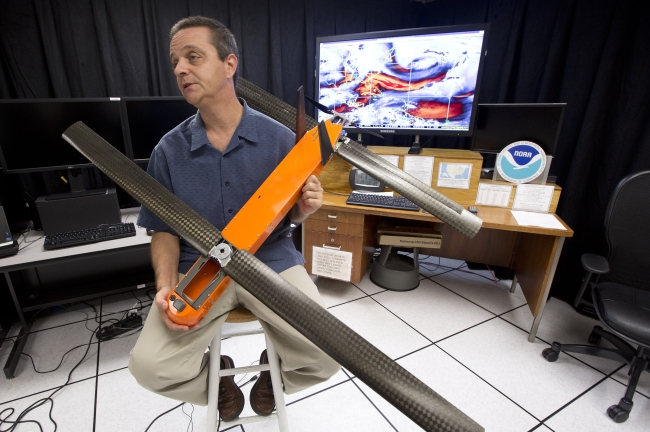MIAMI (AP) ― The point where the roiling ocean meets the fury of a hurricane’s winds may hold the key to improving storm intensity forecasts ― but it’s nearly impossible for scientists to see.
That may change this summer, thanks to post-Hurricane Sandy federal funding and a handful of winged drones that can spend hours spiraling in a hurricane’s dark places, transmitting data that could help forecasters understand what makes some storms fizzle while others strengthen into monsters. Knowing that information while a storm is still far offshore could help emergency managers better plan for evacuations or storm surge risks.
A hurricane is like an engine, and warm ocean water is its fuel. One secret, scientists say, is getting a better understanding of how the warm water transfers energy to tropical storms.
“We really need to get a better idea of what’s going on down there before we even look to improve our intensity forecast,” said Joe Cione, who studies how storms interact with the ocean at the National Oceanic and Atmospheric Administration’s Hurricane Research Division in Miami.
That may change this summer, thanks to post-Hurricane Sandy federal funding and a handful of winged drones that can spend hours spiraling in a hurricane’s dark places, transmitting data that could help forecasters understand what makes some storms fizzle while others strengthen into monsters. Knowing that information while a storm is still far offshore could help emergency managers better plan for evacuations or storm surge risks.
A hurricane is like an engine, and warm ocean water is its fuel. One secret, scientists say, is getting a better understanding of how the warm water transfers energy to tropical storms.
“We really need to get a better idea of what’s going on down there before we even look to improve our intensity forecast,” said Joe Cione, who studies how storms interact with the ocean at the National Oceanic and Atmospheric Administration’s Hurricane Research Division in Miami.

Hurricane hunter aircraft typically don’t fly below 1,520 meters and can’t descend below 450 meters, and real-time radar doesn’t provide information about the thermodynamics at work inside a storm’s cloudy core. Canisters stuffed with electronics dropped from the planes transmit data about a storm’s pressure, temperature, winds and moisture as they fall to the ocean, but they remain airborne for only a few minutes.
The kind of drone that Cione plans to launch from the hurricane hunters will spend hours descending slowly, cruising on the air currents spinning through a storm, possibly even orbiting a hurricane’s eyewall. The amount of data the drone could collect in the lowest parts of a hurricane would give researchers a movie compared to the snapshots sent back by the canisters, Cione said.
The drones have a propeller and are controlled by someone in the hurricane hunter aircraft, but they are designed to float on air currents, not fly against strong winds.
And the small drones are disposable ― once they hit the water, they won’t be recovered.
Hurricane forecasters have gotten good at predicting where a storm is will hit, and the so-called “cone of uncertainty” that shows a storm’s likely path will shrink again this year.
Improvements in predicting changes in the intensity of storms, though, have lagged.
Several factors can alter a storm’s intensity, such as cold water from the ocean’s depths mixing with warm water at the surface, wind shear, the cyclical rebuilding of the wall of clouds that ring a hurricane’s eye or a change in the energy a storm is pulling from the ocean. That last variable is what Cione calls a “data void region,” and it’s where the drones will aim.
-
Articles by Korea Herald



![[AtoZ into Korean mind] Humor in Korea: Navigating the line between what's funny and not](http://res.heraldm.com/phpwas/restmb_idxmake.php?idx=644&simg=/content/image/2024/04/22/20240422050642_0.jpg&u=)
![[Exclusive] Korean military set to ban iPhones over 'security' concerns](http://res.heraldm.com/phpwas/restmb_idxmake.php?idx=644&simg=/content/image/2024/04/23/20240423050599_0.jpg&u=20240423183955)



![[Graphic News] 77% of young Koreans still financially dependent](http://res.heraldm.com/phpwas/restmb_idxmake.php?idx=644&simg=/content/image/2024/04/22/20240422050762_0.gif&u=)
![[Herald Interview] Why Toss invited hackers to penetrate its system](http://res.heraldm.com/phpwas/restmb_idxmake.php?idx=644&simg=/content/image/2024/04/22/20240422050569_0.jpg&u=20240422150649)






![[Exclusive] Korean military to ban iPhones over security issues](http://res.heraldm.com/phpwas/restmb_idxmake.php?idx=652&simg=/content/image/2024/04/23/20240423050599_0.jpg&u=20240423183955)



![[Today’s K-pop] Ateez confirms US tour details](http://res.heraldm.com/phpwas/restmb_idxmake.php?idx=642&simg=/content/image/2024/04/23/20240423050700_0.jpg&u=)